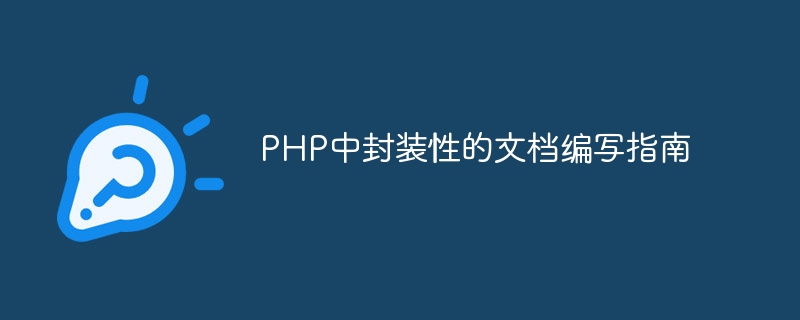Home >Backend Development >PHP Tutorial >A guide to documenting encapsulation in PHP
A guide to documenting encapsulation in PHP
- WBOYWBOYWBOYWBOYWBOYWBOYWBOYWBOYWBOYWBOYWBOYWBOYWBOriginal
- 2023-10-12 11:18:371652browse

Guidelines for documentation of encapsulation in PHP
Encapsulation is an important concept in object-oriented programming, which allows us to combine data and functions to form an independent entity. In PHP, encapsulation is mainly achieved through classes and objects. In order to make better use of encapsulation, it is crucial to write a clear and understandable document. This article will introduce some guidelines for writing encapsulated documentation in PHP and provide some specific code examples.
- Provide a concise summary
The summary section of an encapsulating document should contain a brief introduction to the class or object. This brief introduction should be able to tell the reader the use and purpose of the class or object. You can include a one- or two-sentence summary and an overview of key features.
Example:
/**
* 简单的用户类
* 用于管理用户的基本信息和行为
*/
class User {
// ...
}- Describe the properties of classes and objects in detail
In the document, the properties of classes and objects should be described in detail, including each The property's name, role, data type, default value, and accessibility. For properties with complex structures, subsections can be used for further explanation.
Example:
/**
* 简单的用户类
* 用于管理用户的基本信息和行为
*/
class User {
/**
* 用户名(只能包含字母和数字)
* @var string
*/
public $username;
/**
* 邮箱地址
* @var string
*/
public $email;
/**
* 年龄
* @var int
*/
private $age;
}- Describe the methods of classes and objects in detail
In the document, the methods of classes and objects should be described in detail, including each The name, parameters, return value, function, etc. of the method. For complex methods, a more detailed description can be given, including the steps and implementation details of the method.
Example:
/**
* 简单的用户类
* 用于管理用户的基本信息和行为
*/
class User {
// ...
/**
* 更新用户的密码
*
* @param string $newPassword 新密码
* @return void
*/
public function updatePassword($newPassword) {
// ...
}
/**
* 获取用户的年龄
*
* @return int 用户的年龄
*/
public function getAge() {
// ...
return $this->age;
}
}- Provide sample code
It is very helpful to provide some sample code in the document, they can help readers better understand Understand how to use classes and objects. Sample code should cover common use cases and should be kept as concise and readable as possible.
Example:
$user = new User();
$user->username = 'john123';
$user->updatePassword('newpassword');
echo $user->getAge();- Use comments to explain
It is very important to use comments in source code, it can help other developers better Understand the purpose and implementation logic of the code. In encapsulation documentation, you can provide additional descriptions of classes, properties, and methods in comments. Comments should be clear, concise, and follow a consistent coding style.
Example:
/**
* 简单的用户类
* 用于管理用户的基本信息和行为
*/
class User {
/**
* 用户名(只能包含字母和数字)
* @var string
*/
public $username;
/**
* 邮箱地址
* @var string
*/
public $email;
/**
* 更新用户的密码
*
* @param string $newPassword 新密码
* @return void
*/
public function updatePassword($newPassword) {
// ...
}
/**
* 获取用户的年龄
*
* @return int 用户的年龄
*/
public function getAge() {
// ...
}
}Summary:
In PHP, encapsulation is one of the foundations of object-oriented programming. It is very important to write encapsulating documentation that is clear and easy to understand. Help other developers better understand and use your classes and objects by providing concise summaries, detailed descriptions of their properties and methods, sample code, and comments. I hope the guidelines and examples provided in this article will be helpful when writing PHP encapsulation documentation.
The above is the detailed content of A guide to documenting encapsulation in PHP. For more information, please follow other related articles on the PHP Chinese website!

